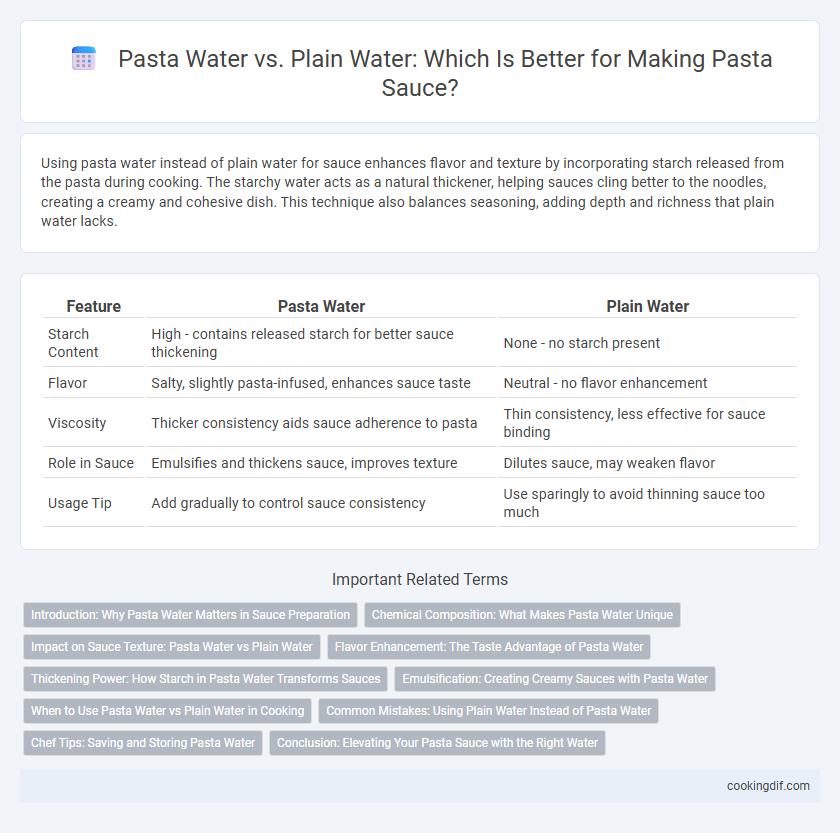Using pasta water instead of plain water for sauce enhances flavor and texture by incorporating starch released from the pasta during cooking. The starchy water acts as a natural thickener, helping sauces cling better to the noodles, creating a creamy and cohesive dish. This technique also balances seasoning, adding depth and richness that plain water lacks.
Table of Comparison
| Feature | Pasta Water | Plain Water |
|---|---|---|
| Starch Content | High - contains released starch for better sauce thickening | None - no starch present |
| Flavor | Salty, slightly pasta-infused, enhances sauce taste | Neutral - no flavor enhancement |
| Viscosity | Thicker consistency aids sauce adherence to pasta | Thin consistency, less effective for sauce binding |
| Role in Sauce | Emulsifies and thickens sauce, improves texture | Dilutes sauce, may weaken flavor |
| Usage Tip | Add gradually to control sauce consistency | Use sparingly to avoid thinning sauce too much |
Introduction: Why Pasta Water Matters in Sauce Preparation
Pasta water contains starch released from cooking pasta, which thickens and binds sauces more effectively than plain water. This starchy liquid helps create a smooth, velvety texture and enhances the sauce's ability to cling to noodles. Using pasta water instead of plain water improves flavor integration and overall sauce consistency in recipes.
Chemical Composition: What Makes Pasta Water Unique
Pasta water contains starches released from cooked pasta, creating a slightly thickened, cloudy liquid rich in amylose and amylopectin molecules. This starch concentration enhances the sauce's texture and acts as a natural emulsifier, allowing fat and water to bind seamlessly. Unlike plain water, pasta water's chemical composition improves sauce adhesion and mouthfeel, making it essential for achieving a silky, cohesive dish.
Impact on Sauce Texture: Pasta Water vs Plain Water
Pasta water contains starch released from cooking, which enhances sauce texture by creating a creamier and more cohesive consistency. Using plain water dilutes the sauce, resulting in a thinner texture without the binding properties provided by starchy pasta water. The mineral content and temperature of pasta water also help emulsify oil and other sauce ingredients, improving overall mouthfeel.
Flavor Enhancement: The Taste Advantage of Pasta Water
Using pasta water instead of plain water for sauce significantly enhances flavor due to the starchy content released during cooking. This starchy water acts as a natural thickener, helping the sauce cling better to the pasta and intensifying its taste profile. The minerals and seasoning absorbed by the water also contribute to a richer, more balanced flavor in the final dish.
Thickening Power: How Starch in Pasta Water Transforms Sauces
Pasta water contains starch released during cooking, which significantly enhances the thickening power of sauces compared to plain water. The starch molecules in pasta water bind with the sauce's fat and water, creating a creamy, velvety texture that plain water cannot achieve. Incorporating reserved pasta water into sauces improves consistency and helps the sauce cling better to pasta surfaces, elevating the overall flavor and mouthfeel.
Emulsification: Creating Creamy Sauces with Pasta Water
Pasta water contains starch released during cooking, which acts as a natural emulsifier to bind oil and water elements in sauces, creating a smooth, creamy texture. Using reserved pasta water instead of plain water helps thicken sauces and improves adherence to pasta by promoting better emulsification. This starch-rich water enables chefs to transform simple sauces like aglio e olio or carbonara into rich, velvety coatings that cling perfectly to each strand or piece.
When to Use Pasta Water vs Plain Water in Cooking
Pasta water contains starch released from the pasta during cooking, making it ideal for thickening and binding sauces to noodles. Use pasta water when you want to create a creamy texture or help emulsify olive oil and cheese in sauces like carbonara or cacio e pepe. Plain water works better for adjusting sauce consistency without adding starch or flavor, especially in broth-based or tomato sauces.
Common Mistakes: Using Plain Water Instead of Pasta Water
Using plain water instead of pasta water for sauce preparation is a frequent mistake that compromises flavor and texture. Pasta water contains starch released during cooking, which acts as a natural thickening agent and helps sauce adhere better to the noodles. Neglecting this ingredient results in a thinner, less cohesive sauce that lacks the rich, silky consistency that enhances pasta dishes.
Chef Tips: Saving and Storing Pasta Water
Chef tips emphasize saving pasta water due to its rich starch content, which enhances sauce texture and helps it cling to pasta more effectively than plain water. Store pasta water by cooling it quickly and keeping it in an airtight container in the refrigerator for up to 24 hours, ensuring the starchiness remains intact for future use. Reheat gently before adding to sauces to restore its binding properties and avoid dilution of flavors.
Conclusion: Elevating Your Pasta Sauce with the Right Water
Using pasta water instead of plain water elevates your sauce by adding starch and salt, enhancing texture and flavor. The starchy liquid helps bind the sauce to the pasta, creating a smoother, creamier consistency. Reserving and incorporating pasta water is an essential technique for achieving restaurant-quality pasta dishes.
Pasta water vs plain water for sauce Infographic

 cookingdif.com
cookingdif.com